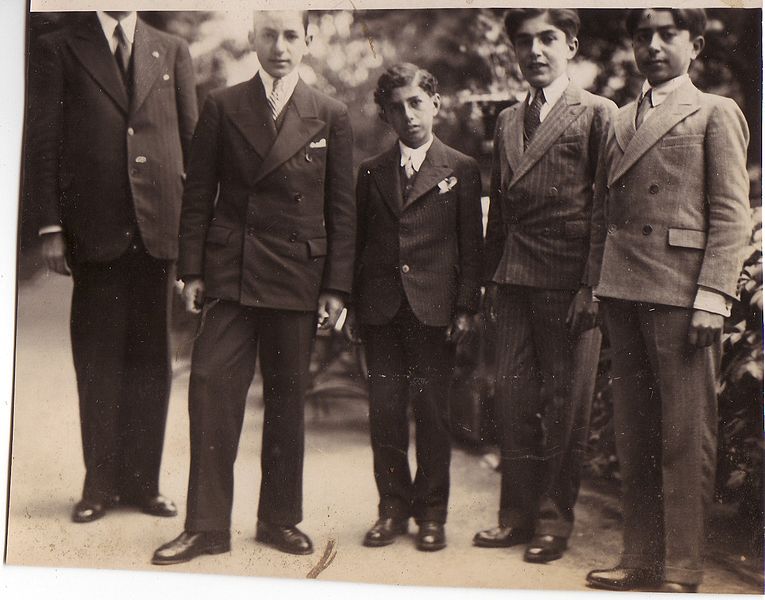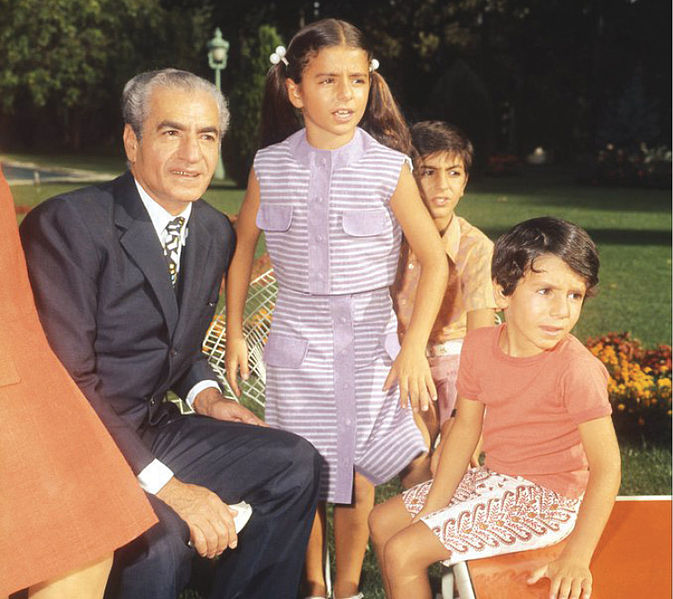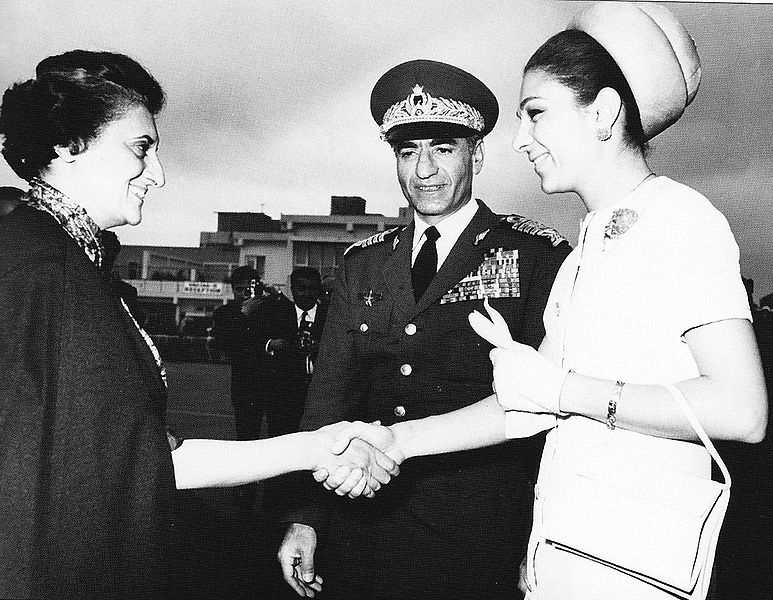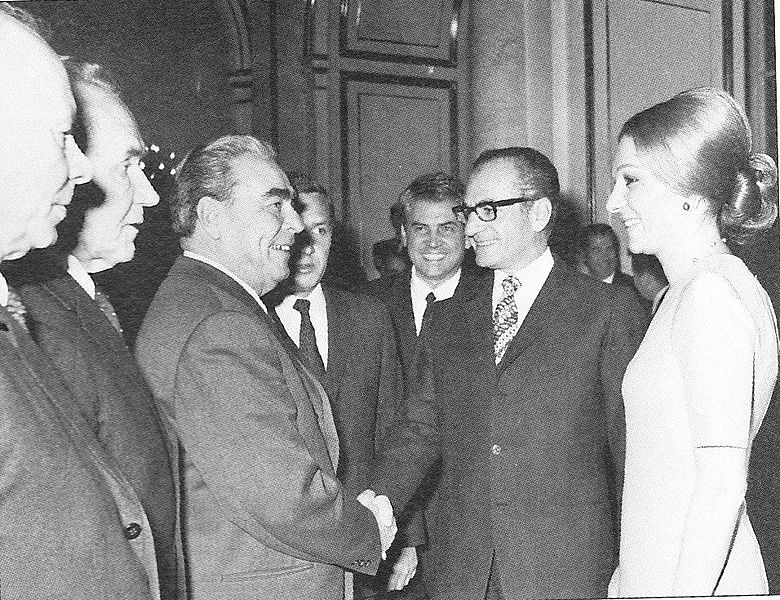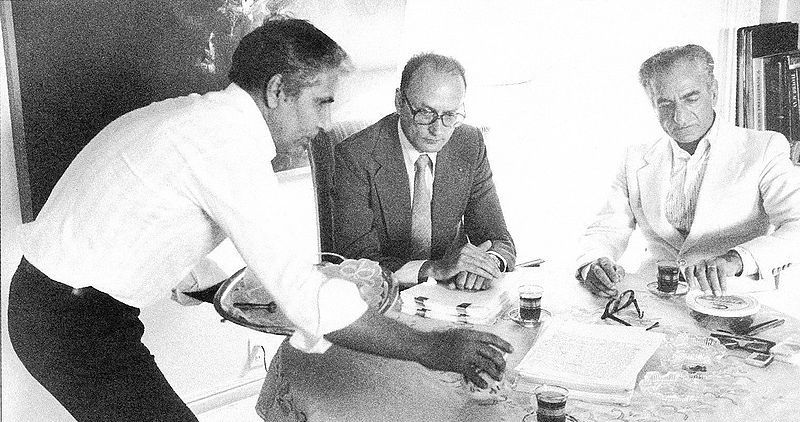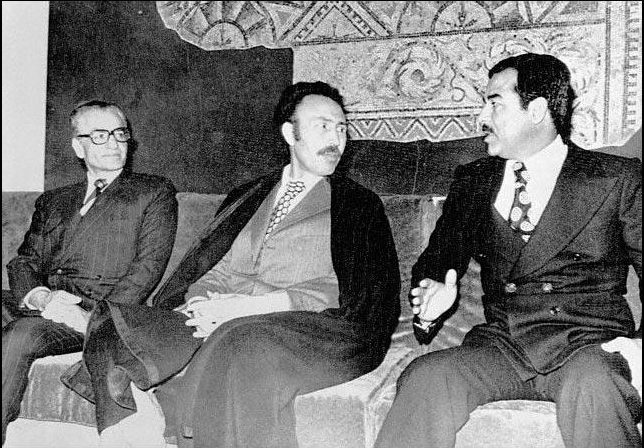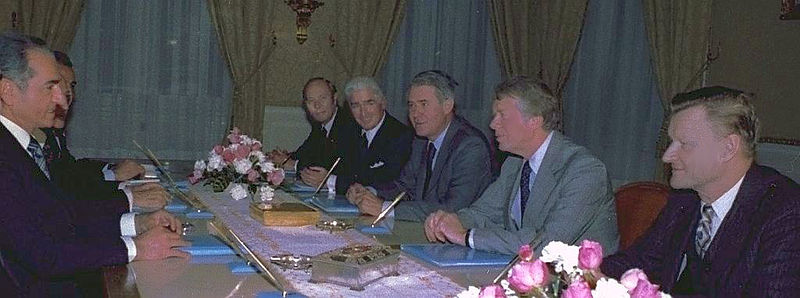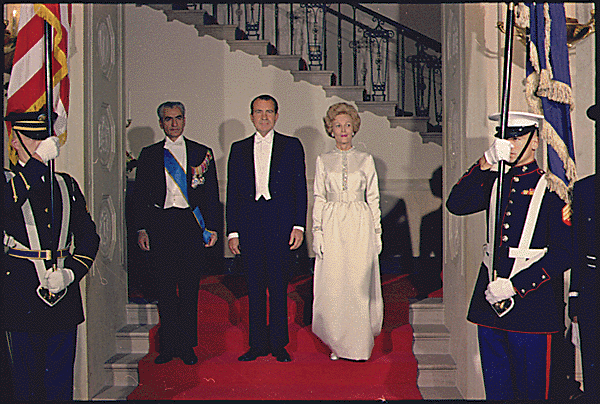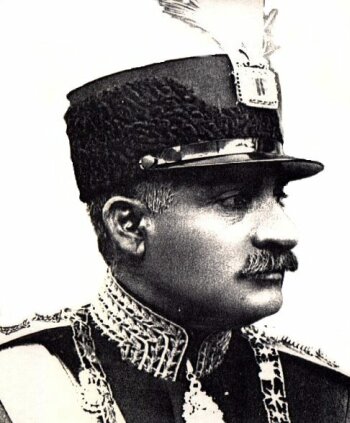<Back to Index>
- Prime Minister of Denmark Thorvald August Marinus Stauning, 1873
- Painter Vasily Vasilyevich Vereshchagin, 1842
- Shah of Iran Mohammad Rezā Pahlavi, 1919
PAGE SPONSOR
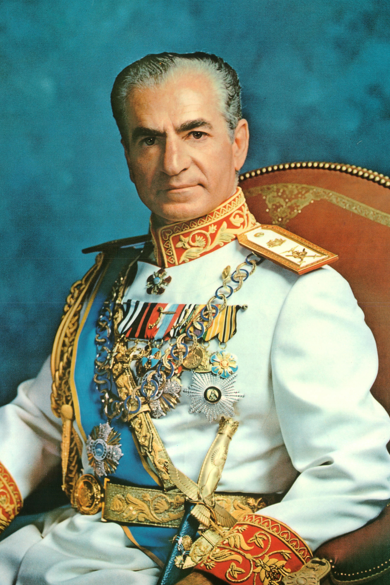
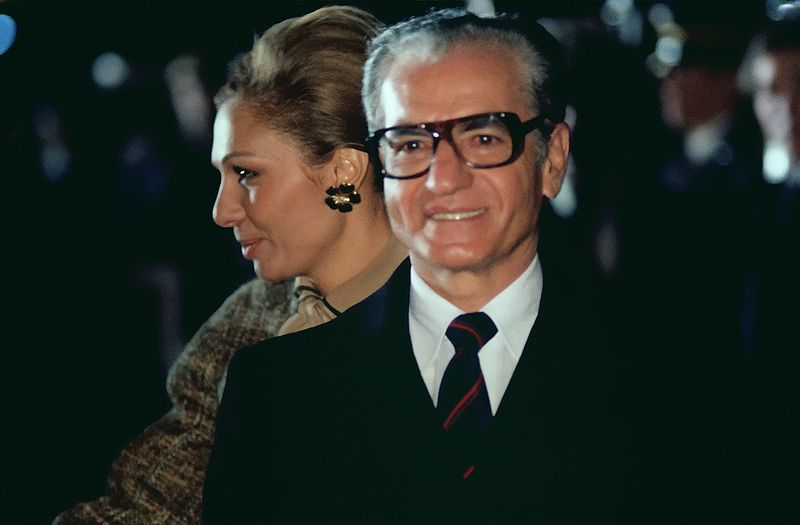
Mohammad Rezā Shāh Pahlavi, Shah of Iran, Shah of Persia (26 October 1919 – 27 July 1980), ruled Iran from 16 September 1941 until his overthrow by the Iranian Revolution on 11 February 1979. He was the second and last monarch of the House of Pahlavi of the Iranian monarchy. Mohammad Reza Shah Pahlavi held several titles: His Imperial Majesty, Shahanshah (King of Kings, Emperor), Aryamehr (Light of the Aryans) and Bozorg Arteshtārān (Head of the Warriors).
The young prince came to power during World War II after an Anglo - Soviet invasion forced the abdication of his father Reza Shah. During his reign, the Iranian oil industry was nationalized under Prime Minister Mohammad Mosaddegh, and Iran marked the anniversary of 2,500 years of continuous monarchy since the founding of the Persian Empire by Cyrus the Great. The Shah's White Revolution, a series of economic and social reforms intended to transform Iran into a global power, succeeded in modernizing the nation, nationalizing many natural resources, and extending suffrage to women.
A secular Muslim himself, the Shah gradually lost support from the Shi'a clergy of Iran, particularly due to his strong policy of modernization, secularization, conflict with the traditional class of merchants known as bazaari, and recognition of Israel. Various additional controversial policies were enacted, including the banning of the communist Tudeh Party, and a general suppression of political dissent by Iran's intelligence agency, SAVAK. Amnesty International reported
that in 1978 Iran had as many as 2,200 political prisoners, a number
which multiplied rapidly within the closest years as a result of the
revolution. Several
other factors contributed to strong opposition to the Shah among
certain groups within Iran, the most notable of which were the U.S. and UK backed coup d'état against Prime Minister Mosaddegh in 1953, clashes with Islamists, and increased communist activity.
By 1979, political unrest had transformed into a revolution which, on
16 January, forced the Shah to leave Iran. Soon thereafter, the Iranian
monarchy was formally abolished, and Iran was declared an Islamic republic. Facing likely execution should he return to Iran, he died in exile in Egypt, whose President, Anwar Sadat, had granted him asylum.
Born in Tehran to Reza Pahlavi and his second wife, Tadj ol-Molouk, Mohammad Reza was the eldest son of the first Shah of the Pahlavi dynasty, and the third of his eleven children. He was born with a twin sister, Ashraf Pahlavi. However, Mohammad Reza, Ashraf,Ali Reza, and their older half - sister, Fatemeh, were born as non-royals, as their father did not become Shah until 1925. Yet Reza Shah was always convinced that his sudden quirk of good fortune had commenced in 1919 with the birth of his son who was dubbed khoshghadam (bird of good omen).
By the time the Crown Prince attained 11 years of age, his father deferred to the recommendation of Abdolhossein Teymourtash to dispatch his son to Institut Le Rosey,
a Swiss boarding school for further studies. Mohammad Reza Shah would
be the first Iranian prince in line for the throne to be sent abroad to
attain a foreign education and remained there for the next four years
before returning to obtain his high school diploma in Iran in 1936.
After returning to the country, the Crown Prince was registered at the
local military academy in Tehran where he remained enrolled until 1938.
In the midst of World War II in 1941, Nazi Germany began Operation Barbarossa and invaded the Soviet Union, breaking the Molotov - Ribbentrop Pact. This had a major impact on Iran, which had declared neutrality in the conflict.
That year British and Soviet forces violated Iranian neutrality and occupied Iran via military invasion, forcing Reza Shah to abdicate. Prince Mohammad Reza replaced him on the throne on 16 September 1941. Subsequent to his succession as Shah, Iran became a major conduit for British and, later, American aid to the USSR during the war. This massive supply effort became known as the Persian Corridor, an involvement that would continue to grow until the successful revolution against the Iranian monarchy in 1979.
Much of the credit for orchestrating a smooth transition from Reza Shah to his son was due to the efforts of Mohammad Ali Foroughi. Suffering from Angina pectoris, a frail Foroughi was summoned to the Palace and appointed Prime Minister when Reza Shah feared the end of the Pahlavi dynasty once the allies invaded Iran in 1941. When Reza Shah sought his assistance to ensure that the Allies would not put an end to the Pahlavi dynasty, Foroughi put aside his adverse personal sentiments for having been politically sidelined since 1935. The Crown Prince confided in amazement to the British Minister that Foroughi “hardly expected any son of Reza Shah to be a civilized human being” but Foroughi successfully derailed thoughts by the Allies to undertake a more drastic change in the political infrastructure of Iran.
A general amnesty was issued two days after Mohammad Reza Shah's accession to the throne on September 19, 1941. All political personalities who had suffered disgrace during his father’s reign were rehabilitated, and the forced unveiling policy inaugurated by his father in 1935 was overturned. Despite the young Shah's enlightened decisions, the British Minister in Tehran reported to London that "the young Shah received a fairly spontaneous welcome on his first public experience, possibly rather [due] to relief at the disappearance of his father than to public affection for himself.” Reza Shah's years of terror, from the start, would mar the new Shah's prospects of success.
Despite
his public professions of admiration in later years, the young Shah had
serious misgivings about not only the coarse and roughshod political
means adopted by his father, but also his unsophisticated approach to
the affairs of the state. The
young Shah possessed a decidedly more refined temperament, and among
the unsavoury developments that “would haunt him when he was king” were
the fates visited on Teymourtash; the dismissal of Foroughi by the mid 1930s; and Ali Akbar Davar’s
decision to commit suicide in 1937. An even more significant decision
that cast a long shadow was the
disastrous and one - sided agreement his father had negotiated with APOC
in 1933, one which compromised the country's ability to receive more
favourable returns from oil extracted from the country.
By the early 1950s, the political crisis brewing in Iran commanded the attention of British and American policy leaders. In 1951 Dr. Mosaddegh was appointed Prime Minister and committed to nationalizing the Iranian petroleum industry controlled by the Anglo - Persian Oil Company. Under the leadership of the democratically elected nationalist movement of Dr. Mohammed Mosaddeq, the Iranian parliament unanimously voted to nationalize the oil industry – thus shutting out the immensely profitable Anglo - Iranian Oil Company (AIOC), which was a pillar of Britain's economy and provided it political clout in the region.
At the start of the confrontation, American political sympathy was forthcoming from the Truman Administration. In particular, Mossadegh was buoyed by the advice and counsel he was receiving from American Ambassador in Tehran, Henry F. Grady. However, eventually American decision makers lost their patience, and by the time a Republican Administration came to office fears that the Communists were poised to overthrow the government became an all consuming concern (these concerns were later dismissed as "paranoid" in retrospective commentary on the coup from US government officials). Shortly prior to the 1952 presidential elections in the US, the British government invited Kermit Roosevelt, Jr., of the CIA to London to propose collaboration on a secret plan, codenamed "Operation Ajax", to force Mosaddegh from office. This would be the first of three "regime change" operations led by Allen Dulles (the other two being the successful CIA instigated 1954 Guatemalan coup d'état and the failed Bay of Pigs Invasion of Cuba).
Under the direction of Kermit Roosevelt, Jr., a senior Central Intelligence Agency (CIA) officer and grandson of former U.S. President Theodore Roosevelt, the American CIA and British Secret Intelligence Service (SIS) funded and led a covert operation to depose Mosaddegh with the help of military forces loyal to the Shah. Referred to as Operation Ajax, the plot hinged on orders signed by the Shah to dismiss Mosaddegh as prime minister and replace him with General Fazlollah Zahedi – a choice agreed on by the British and Americans.
Despite the high level coordination and planning, the coup initially failed, causing the Shah to flee to Baghdad, then Rome. After a brief exile in Italy, the Shah returned to Iran, this time through a successful second attempt at a coup. A deposed Mosaddegh was arrested and tried. The King intervened and commuted the sentence to one and a half years. Zahedi was installed to succeed Prime Minister Mosaddegh.
Before the first attempted coup, the American Embassy in Tehran reported that Mosaddegh's popular support remained robust. The Prime Minister requested direct control of the army from the Majlis. Given the situation, alongside the strong personal support of Eden and Churchill for covert action, the American government gave the go-ahead to a committee, attended by the Secretary of State John Foster Dulles, Director of Central Intelligence Allen Dulles, Kermit Roosevelt, Ambassador Henderson, and Secretary of Defense Charles Erwin Wilson. Kermit Roosevelt returned to Iran on 13 July 1953, and again on 1 August 1953, in his first meeting with the Shah. A car picked him up at midnight and drove him to the palace. He lay down on the seat and covered himself with a blanket as guards waved his driver through the gates. The Shah got into the car and Roosevelt explained the mission. The CIA provided $1 million in Iranian currency, which Roosevelt had stored in a large safe – a bulky cache, given the exchange rate at the time of 1000 rial to 15 dollars.
The Communists staged massive demonstrations to hijack the Prime Minister’s initiatives. The United States had announced its total lack of confidence in him; and his followers were drifting into indifference. On 16 August 1953, the right wing of the Army reacted. Armed with an order by the Shah, it appointed General Fazlollah Zahedi as prime minister. A coalition of mobs and retired officers close to the Palace attempted what could be described as a coup d’état. They failed dismally and the Shah fled the country in humiliating haste. Even Ettelaat, the nation’s largest daily newspaper, and its pro-Shah publisher, Abbas Masudi, published negative commentaries on him.
During the following two days, the Communists turned against Mosaddegh. Opposition against him grew tremendously. They roamed Tehran raising red flags and pulling down statues of Reza Shah. This frightened the conservative clerics like Kashani and National Front leaders like Makki, who sided with the Shah. On 18 August 1953, Mosaddegh hit back. Tudeh Partisans were clubbed and dispersed.
Tudeh had no choice but to accept defeat. In the meantime, according to the CIA plot, Zahedi appealed to the military, and claimed to be the legitimate prime minister and charged Mosaddegh with staging a coup by ignoring the Shah’s decree. Zahedi’s son Ardeshir acted as the contact between the CIA and his father. On 19 August 1953, pro-Shah partisans – organized with $100,000 in CIA funds – finally appeared and marched out of south Tehran into the city center, where others joined in. Gangs with clubs, knives, and rocks controlled the streets, overturning Tudeh trucks and beating up anti - Shah activists. As Roosevelt was congratulating Zahedi in the basement of his hiding place, the new Prime Minister’s mobs burst in and carried him upstairs on their shoulders. That evening, Ambassador Henderson suggested to Ardashir that Mosaddegh not be harmed. Roosevelt gave Zahedi US$ 900,000 left from Operation Ajax funds.
To many, U.S. actions further solidified sentiments that the West was a meddlesome influence in Iranian politics. In the year 2000, reflecting on this notion, U.S. Secretary of State Madeleine K. Albright stated:
"In 1953 the United States played a significant role in orchestrating the overthrow of Iran's popular Prime Minister, Mohammed Mossadegh. The Eisenhower Administration believed its actions were justified for strategic reasons; but the coup was clearly a setback for Iran's political development. And it is easy to see now why many Iranians continue to resent this intervention by America in their internal affairs."
The Shah returned to power, but never extended the elite status of the court to the technocrats and intellectuals who emerged from Iranian and Western universities. Indeed, his system irritated the new classes, for they were barred from partaking in real power.
The Shah was a strong supporter and patron of the Iran Scout Organization. A stamp showing the Shah in Scout's uniform was issued in 1956. In 1960 during a state visit the Shah was awarded the highest award of Pfadfinder Österreichs (Silberner Steinbock am rot-weiß-rotten Band), the National Scout Organisation of Austria.
The Shah was the target of at least two unsuccessful assassination attempts. On 4 February 1949, the Shah attended an annual ceremony to commemorate the founding of Tehran University. At the ceremony, Fakhr - Arai fired five shots at the Shah at a range of ten feet. Only one of the shots hit the Shah and his cheek was grazed. Fakhr - Arai was instantly shot by nearby officers. After an investigation, it was determined that Fakhr - Arai was a member of the Tudeh Party, which was subsequently banned. However, there is evidence that the would-be assassin was not a Tudeh member but a religious fundamentalist member of Fada'iyan-e Islam. The Tudeh was nonetheless blamed and persecuted.
The second attempt on the Shah's life occurred on 10 April 1965. A soldier shot his way through the Marble Palace. The assassin was killed before he reached the Shah's quarters. Two civilian guards died protecting the Shah.
According to Vladimir Kuzichkin – a former KGB officer who defected to the SIS – the Shah was also allegedly targeted by the Soviet Union, who tried to use a TV remote control to detonate a bomb - laden Volkswagen Beetle. The TV remote failed to function. A high ranking Romanian defector Ion Mihai Pacepa also supported this claim, asserting that he had been the target of various assassination attempts by Soviet agents for many years.
The Shah supported the Yemeni royalists against republican forces in the Yemen Civil War (1962 – 70) and assisted the sultan of Oman in putting down a rebellion in Dhofar (1971). Concerning the fate of Bahrain (which Britain had controlled since the 19th century, but which Iran claimed as its own territory) and three small Persian Gulf islands, the Shah negotiated an agreement with the British, which, by means of a public consensus, ultimately led to the independence of Bahrain (against the wishes of Iranian nationalists). In return, Iran took full control of Greater and Lesser Tunbs and Abu Musa in the Strait of Hormuz, three strategically sensitive islands which were claimed by the United Arab Emirates.
During
this period, the Shah maintained cordial relations with the Persian
Gulf states and established close diplomatic ties with Saudi Arabia. Relations with Iraq,
however, were often difficult due to political instability in the
latter country. The Shah was distrustful of both the Socialist government of Abd al-Karim Qasim and the Arab nationalist Baath party. In April 1969, Mohammad Reza abrogated the 1937 Iranian - Iraqi treaty over control of the Shatt al-Arab, and as such, Iran ceased paying tolls to Iraq when its ships used the Shatt al-Arab. The Shah justified his move by arguing that almost all river borders all over the world ran along the thalweg (deep
channel mark), and by claiming that because most of the ships that used
the Shatt al-Arab were Iranian, the 1937 treaty was unfair to Iran. Iraq
threatened war over the Iranian move, but when on 24 April 1969 an
Iranian tanker escorted by Iranian warships sailed down the Shatt
al-Arab, Iraq being the militarily weaker state did nothing. The
Iranian abrogation of the 1937 treaty marked the beginning of a period
of acute Iraqi - Iranian tension that was to last until the Algiers
Accords of 1975. He
financed Kurdish separatist rebels, and to cover his tracks, armed them
with Soviet weapons which Israel had seized from Soviet backed Arab
regimes, and then handed over to Iran at the Shah's behest. The initial
operation was a disaster, but the Shah continued attempts to support the
rebels and weaken Iraq. Then in 1975, the countries signed the Algiers Accord, which granted Iraq equal navigation rights in the Shatt al-Arab river, while the Shah agreed to end his support for Iraqi Kurdish rebels.
The Shah also maintained close relations with King Hussein of Jordan, Anwar Sadat of Egypt, and King Hassan II of Morocco.
On July 1964, Shah Pahlavi, Turkish President Cemal Gürsel and Pakistani President Ayub Khan announced in Istanbul the establishment of the Regional Cooperation for Development (RCD) organization to promote joint transportation and economic projects. It also envisioned Afghanistan's joining some time in the future.
The Shah maintained close relations with Pakistan also. During the Second Indian - Pakistani war of 1965 between Pakistan and India, the Shah provided free fuel to the Pakistani planes, which landed on Iranian soil, refueled and then took flight.
The Shah of Iran was the first Muslim leader to recognize the State of Israel, although when interviewed on CBS 60 Minutes by reporter Mike Wallace, he criticized American Jews for their presumed control over US media and finance.
With Iran's great oil wealth, Mohammad Reza Shah became the pre-eminent leader of the Middle East, and self - styled "Guardian" of the Persian Gulf. In 1961 he defended his style of rule, saying "when Iranians learn to behave like Swedes, I will behave like the King of Sweden."
During
the last years of his government, the Shah's government became more
centralized. In the words of a US Embassy dispatch, “The Shah’s picture
is everywhere. The beginning of all film showings in public theaters
presents the Shah in various regal poses accompanied by the strains of
the National anthem... The monarch also actively extends his influence
to all phases of social affairs... there is hardly any activity or
vocation which the Shah or members of his family or his closest friends
do not have a direct or at least a symbolic involvement. In the past, he
had claimed to take a two party - system seriously and declared “If I
were a dictator rather than a constitutional monarch, then I might be
tempted to sponsor a single dominant party such as Hitler organized”.
By 1975, he abolished the multi - party system of government in favor of a one - party state under the Rastakhiz (Resurrection)
Party. The Shah’s own words on its justification was; “We must
straighten out Iranians’ ranks. To do so, we divide them into two
categories: those who believe in Monarchy, the constitution and the Six
Bahman Revolution and those who don’t.... A person who does not enter
the new political party and does not believe in the three cardinal
principles will have only two choices. He is either an individual who
belongs to an illegal organization, or is related to the outlawed Tudeh
Party, or in other words a traitor. Such an individual belongs to an
Iranian prison, or if he desires he can leave the country tomorrow,
without even paying exit fees; he can go anywhere he likes, because he
is not Iranian, he has no nation, and his activities are illegal and
punishable according to the law”. In addition, the Shah had decreed that all Iranian citizens and the few remaining political parties become part of Rastakhiz.
The Shah made major changes to curb the power of certain ancient elite factions by expropriating large and medium - sized estates for the benefit of more than four million small farmers. In the White Revolution, he took a number of major modernization measures, including extending suffrage to women, in accordance to the Islamic Law, the participation of workers in factories through shares and other measures, the improvement of the educational system through new elementary schools and literacy courses set up in remote villages by the Imperial Iranian Armed Forces. The latter step was called "Sepāh e Dānesh", "Army of Knowledge". As part of the White Revolution, the Armed Forces were engaged in infrastructural and other educational projects throughout the country ("Sepāh e Tarvij va Âbādāni") as well as in health education and promotion ("Sepāh e Behdāsht"). Moreover, he instituted exams for Islamic theologians to become established clerics. As a further step, in the seventies the governmental program of a free of charge nourishment for children at school ("Taghzieh e Rāigān") was implemented. Under the Shah's reign, the national Iranian income showed an unprecedented rise.
In the field of diplomacy, Iran realized and maintained friendly relations with Western and East European countries as well as the state of Israel and China and became, especially through the close friendship with the United States, more and more a hegemonial power in the Persian Gulf region and the Middle East. The suppression of the communist guerilla movement in the region of Dhofar in Oman with the help of the Iranian army after a formal request by Sultan Qaboos was widely regarded in this context. As to infrastructural and technological progress, the Shah continued and developed further the policies introduced by his father. As part of his programs, projects in several technologies, such as steel, telecommunications, petrochemical facilities, power plants, dams and the automobile industry may be named.
In terms of cultural activities, international cooperations were encouraged and organized, such as the Shiraz Arts Festival. Many Iranian students were sent to and supported in foreign, especially Western countries and the Indian subcontinent. The Aryamehr University of Technology was established as a major new academic institution.
As part of his various financial support programs in the fields of culture and arts, the Shah, along with King Hussein of Jordan donated an amount to the Chinese Muslim Association for the construction of the Taipei Grand Mosque.
At the Federation of American Scientists, John Pike writes:
In 1978 the deepening opposition to the Shah erupted in widespread demonstrations and rioting. Recognizing that even this level of violence had failed to crush the rebellion, the Shah abdicated the Peacock Throne and departed Iran on 16 January 1979. Despite decades of pervasive surveillance by SAVAK, working closely with CIA, the extent of public opposition to the Shah, and his sudden departure, came as a considerable surprise to the US intelligence community and national leadership. As late as 28 September 1978 the US Defense Intelligence Agency reported that the Shah "is expected to remain actively in power over the next ten years."
Explanations for why the Shah was overthrown include that he was beholden to a non-Muslim Western power, (the United States) whose foreign culture was seen as influencing that of Iran. Additional contributing factors included perceptions of oppression, brutality, corruption, and extravagance. Basic functional failures of the regime have also been blamed — economic bottlenecks, shortages and inflation; the regime's over - ambitious economic program; the failure of its security forces to deal with protest and demonstration; the overly centralized royal power structure.
In October 1971, the Shah celebrated the twenty - five - hundredth anniversary of the Iranian monarchy. The New York Times reported that $100 million was spent. Next to the ancient ruins of Persepolis, the Shah gave orders to build a tent city covering 160 acres (0.65 km2), studded with three huge royal tents and fifty - nine lesser ones arranged in a star - shaped design. French chefs from Maxim’s of Paris prepared breast of peacock for royalty and dignitaries around the world, the buildings were decorated by Maison Jansen (the same firm that helped Jacqueline Kennedy redecorate the White House), the guests ate off Limoges porcelain china and drank from Baccarat crystal glasses. This became a major scandal as the contrast between the dazzling elegance of celebration and the misery of the nearby villages was so dramatic that no one could ignore it. Months before the festivities, university students struck in protest. Indeed, the cost was so sufficiently impressive that the Shah forbade his associates to discuss the actual figures.
However the Shah and the supporters of the Shah argue that the celebrations opened new investments in Iran, improved relationships with the other leaders and nations of the world, and provided greater recognition of Iran. Other actions that are thought to have contributed to his downfall include antagonizing formerly apolitical Iranians — especially merchants of the bazaars — with the creation in 1975 of a single party political monopoly (the Rastakhiz Party), with compulsory membership and dues, and general aggressive interference in the political, economic, and religious concerns of people's lives; and the 1976 change from an Islamic calendar to an Imperial calendar, marking the birth of Cyrus as the first day, instead of the flight of the Prophet Muhammad from Mecca to Medina. Overnight, the year changed from 1355 to 2535.
Some
achievements of the Shah — such as broadened education — had unintended
consequences. While school attendance rose (by 1966 the school
attendance of urban seven to fourteen year olds was estimated at 75.8%),
Iran's labor market could not absorb a high number of educated youth.
In 1966 high school graduates had "a higher rate of unemployment than
did the illiterate," and educated unemployed often supported the revolution.
The overthrow of the Shah came as a surprise to almost all observers. The first militant anti - Shah demonstrations of a few hundred started in October 1977, after the death of Khomeini's son Mostafa. A year later strikes were paralyzing the country, and in early December a "total of 6 to 9 million" — more than 10% of the country — marched against the Shah throughout Iran.
On 16 January 1979, he made a contract with Farboud and left Iran at the behest of Prime Minister Shapour Bakhtiar (a
long time opposition leader himself), who sought to calm the situation.
Spontaneous
attacks by members of the public on statues of the Pahlavis followed,
and "within hours, almost every sign of the Pahlavi dynasty" was
destroyed. Bakhtiar dissolved SAVAK, freed all political prisoners, and allowed the Ayatollah Khomeini to return to Iran after years in exile. He asked Khomeini to create a Vatican like state in Qom, promised free elections, and called upon the opposition to help
preserve the constitution, proposing a "national unity" government
including Khomeini's followers. Khomeini fiercely rejected Bakhtiar's
demands and appointed his own interim government, with Mehdi Bazargan as
prime minister, stating that "since I have appointed him, he must be
obeyed." In February, pro-Khomeini revolutionary guerrilla and rebel
soldiers gained the upper hand in street fighting, and the military
announced its neutrality. On the evening of 11 February, the dissolution of the monarchy was complete.
During his second exile, the Shah traveled from country to country seeking what he hoped would be temporary residence. First he flew to Assuan, Egypt, where he received a warm and gracious welcome from President Anwar El-Sadat. He later lived in Morocco as a guest of King Hassan II, as well as in the Bahamas, and in Cuernavaca in Mexico near Mexico City, as a guest of José López Portillo. He suffered from gallstones that would require prompt surgery. He was offered treatment in Switzerland, but insisted on treatment in the United States.
On 22 October 1979, at the request of David Rockefeller and Henry Kissinger, President Jimmy Carter reluctantly allowed the Shah into the United States to undergo surgical treatment at the New York – Weill Cornell Medical Hospital. While in Cornell Medical Center, Shah used the name "David D. Newsom" as his temporary code name, without Newsom's knowledge.
The Shah was taken later by U.S. Air Force jet to Kelly Air Force Base in Texas and from there to Wilford Hall Medical Center at Lackland Air Force Base. It
was anticipated that his stay in the U.S. would be short; however,
surgical complications ensued, which required six weeks of confinement
in the hospital before he recovered. His prolonged stay in the U.S. was
extremely unpopular with the revolutionary movement in Iran, which still
resented the United States' overthrow of Prime Minister Mosaddeq and
the years of support for the Shah's rule. The Iranian government
demanded his return to Iran, but he stayed in the hospital.
There are claims that this resulted in the storming of the U.S. Embassy in Tehran and the kidnapping of American diplomats, military personnel, and intelligence officers, which soon became known as the Iran hostage crisis. According to the Shah's book, Answer to History, in the end the USA never provided the Shah any kind of health care and asked him to leave the country.
He left the United States on 15 December 1979 and lived for a short time in the Isla Contadora in Panama. The new government in Iran still demanded his and his wife's immediate extradition to Tehran. A short time after the Shah's arrival, an Iranian ambassador was dispatched to the Central American nation carrying a 450 page extradition request. That official appeal greatly alarmed both the Shah and his advisors. Whether the Panamanian government would have complied is a matter of speculation among historians.
After that event, the Shah again sought the support of Egyptian president Anwar El-Sadat, who renewed his offer of permanent asylum in Egypt to the ailing monarch. The Shah returned to Egypt in March 1980, where he received urgent medical treatment, but nevertheless died from complications of Waldenström's macroglobulinemia (a type of non-Hodgkin lymphoma) on 27 July 1980, aged 60. Egyptian President Sadat gave the Shah a state funeral.
Mohammad Reza Pahlavi is buried in the Al Rifa'i Mosque in
Cairo, a mosque of great symbolic importance. The last royal rulers of
two monarchies are buried there, Mohammad Reza Shah Pahlavi of Iran and
King Farouk of Egypt, his former brother - in - law. The tombs lie to the left of the entrance. Years earlier, his father and predecessor, Reza Shah Pahlavi had also initially been buried at the Al Rifa'i Mosque.
In 1969, the Shah sent one of 73 Apollo 11 Goodwill Messages to NASA for the historic first lunar landing. The message still rests on the lunar surface today. He stated in part, "...we pray the Almighty God to guide mankind towards ever increasing success in the establishment of culture, knowledge and human civilization." The Apollo 11 crew visited the Shah during a world tour.
Shortly after his overthrow, Mohammad Reza Pahlavi wrote an autobiographical memoir Réponse à l'histoire (Answer to History). It was translated from the original French into English, Persian (Pasokh be Tarikh), and other languages. However, by the time of its publication, the Shah had already died. The book is his personal account of his reign and accomplishments, as well as his perspective on issues related to the Iranian Revolution and Western foreign policy toward Iran. The Shah places some of the blame for the wrongdoings of SAVAK and the failures of various democratic and social reforms (particularly through the White Revolution) upon Amir Abbas Hoveyda and his administration.
In
the 1990s and the decade following 2000, the Shah's reputation has
staged something of a revival, with many Iranians looking back on his
era as a time when Iran was more prosperous and the government less
oppressive. Younger generation of Iranians find it "impossible to understand what their parents were so passionate about." Journalist Afshin Molavi reports
even members of the uneducated poor – traditionally core supporters of
the revolution that overthrew the Shah – making remarks such as 'God
bless the Shah's soul, the economy was better then;' and finds that
"books about the former Shah (even censored ones) sell briskly," while "books of the Rightly Guided Path sit idle."
Under Mohammad Reza Pahlavi's father, the government supported advancements by women against child marriage, polygamy, exclusion from public society, and education segregation.
However, independent feminist political groups were shut down and
forcibly integrated into one state - created institution, which maintained
many paternalistic views.
Despite substantial opposition from Shiite religious jurists, the
Iranian feminist movement, led by activists such as Fatemah Sayyeh,
achieved further advancement under Mohammad Reza Pahlavi. His regime's
changes focused on the civil sphere, and private - oriented family law
remained restrictive, although the 1967 and 1975 Family Protection Laws attempted to reform this trend. Specifically, women gained the right to become ministers such as Farrokhroo Parsa and judges such as Shirin Ebadi, as well as any other profession regardless of their sex.
Dilawar Princess Fawzia of Egypt (born 5 November 1921), a daughter of King Fuad I of Egypt and Nazli Sabri; she also was a sister of King Farouk I of Egypt. They married in 1939 and were divorced in 1945 (Egyptian divorce) and 1948 (Iranian divorce). Together they had one child, a daughter.
His second wife was Soraya Esfandiary - Bakhtiari (22 June 1932 – 26 October 2001), the only daughter of Khalil Esfandiary, Iranian Ambassador to the Federal Republic of Germany, and his wife, the former Eva Karl. They married in 1951, but divorced in 1958 when it became apparent that she could not bear children. Soraya later told The New York Times that the Shah had no choice but to divorce her, and that he was heavy hearted about the decision.
He subsequently indicated his interest in marrying Princess Maria Gabriella of Savoy, a daughter of the deposed Italian king, Umberto II. Pope John XXIII reportedly
vetoed the suggestion. In an editorial about the rumors surrounding the
marriage of "a Muslim sovereign and a Catholic princess", the Vatican
newspaper, L'Osservatore Romano, considered the match "a grave danger," especially considering that under the 1917 Code of Canon Law a Roman Catholic who married a divorced person would be automatically, and could be formally, excommunicated.
Mohammad Reza Pahlavi married his third and final wife, Farah Diba (born 14 October 1938), the only child of Sohrab Diba, Captain in the Imperial Iranian Army (son of an Iranian Ambassador to the Romanov Court in Moscow, Russia), and his wife, the former Farideh Ghotbi. They were married in 1959, and Queen Farah was crowned Shahbanu, or Empress, a title created especially for her in 1967. Previous royal consorts had been known as "Malakeh" (Arabic: Malika), or Queen. The couple remained together for twenty years, until the Shah's death. Farah Diba bore him four children.
